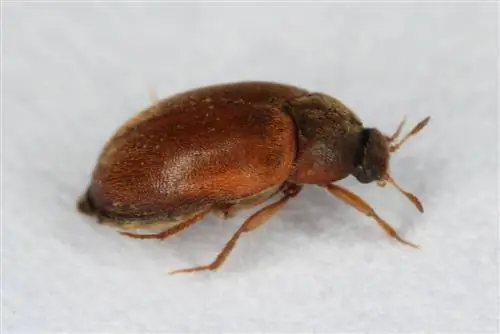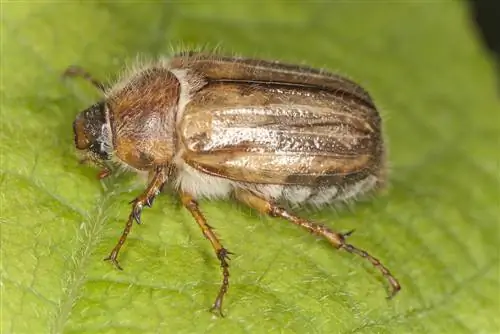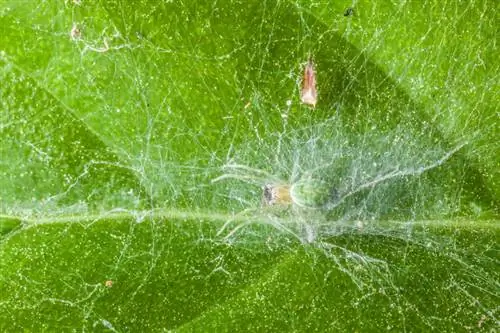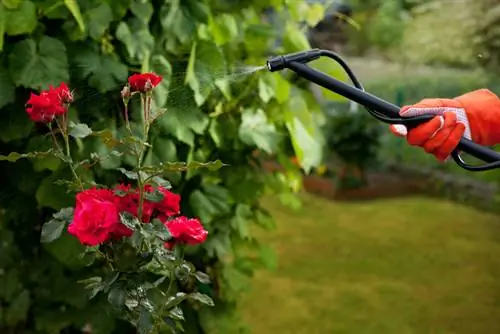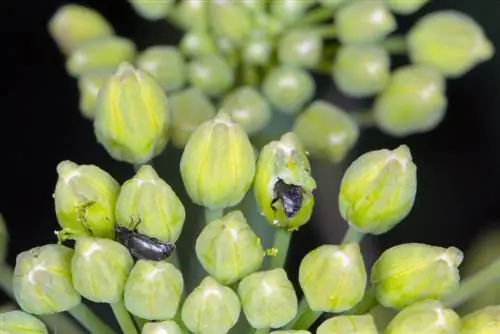- Author admin [email protected].
- Public 2023-12-16 16:46.
- Last modified 2025-06-01 06:02.
Do you have brown mini beetles in your house? Don't hesitate to make a precise determination, as they can be dreaded pests of storage and materials. This guide will familiarize you with important facts about its appearance and location. This is how you can recognize small brown beetles in your apartment right away.
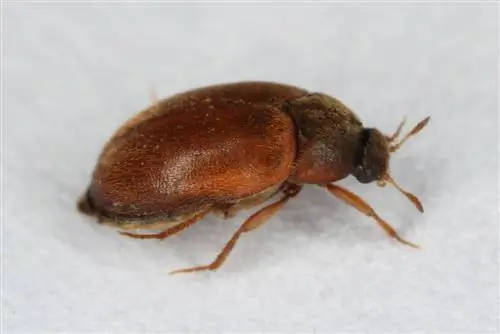
What little brown beetles are there in the apartment?
Small brown beetles in the home can be bread beetles, brown fur beetles, grain beetles, carpet beetles or cockroaches. They are often found in the kitchen, bedroom or windowsill and can cause damage to supplies, textiles or wood.
- Flying, small brown beetles in the house are often 2-3 mm long bread beetles that attack dry supplies or nibble on wood, paper and books.
- Brown mini beetles in the apartment with a size of 2-5 mm, elongated to wide-oval body shape are called brown fur beetles, grain beetles and carpet beetles.
- If a small, beetle-like insect rushes around at night, it is usually the lightning-fast, 10-15 mm large cockroach with a characteristic flat-oval body shape and epically long antennae.
Identifying small brown beetles
Knowing a handful of facts is enough to correctly identify beetles in the house. Ideally, you should have a magnifying glass (€4.00 on Amazon) at hand to accurately check the information in the following table. These 5 beetle species are small, brown and have the guts to live in the apartment:
| Small brown beetle species | bread beetle | Brown Fur Beetle | grain beetle | carpet beetle | Cockroach |
|---|---|---|---|---|---|
| Size | 2-3mm | 2, 3-5 mm | 2, 5-5 mm | 3-4, 5mm | 10-15mm |
| Body shape | oval | elongated | elongated | wide oval to spherical | flat-oval |
| Cover color | red-brown | light brown | dark to black-brown | glossy black-brown | red brown to dark brown |
| Color legs | brown | brown | dark brown | black | brown to dark brown |
| Special feature | with hard armor | densely hairy elytra | long trunk | colored scale pattern | very long antennae |
| Typical location | in the kitchen | on the windowsill | in the kitchen | in the room | in the bathroom |
| Botanical name | Stegobium paniceum | Attagenus smirnovi | Sitophilus granarius | Anthrenus scrophulariae | Blattella germanica |
| Middle name | Bookworm | fur beetle | none | Brownroot flower beetle | cockroach |
| Beetle Family | Rodent Beetle | Speck Beetle | Weevils | Speck Beetle | Cockroaches |
Do you still have doubts about the true identity of the brown mini beetles in question? Then read the following in-depth information about the appearance and frequently frequented places in the house.
Identifying bread beetles - facts about appearance and location
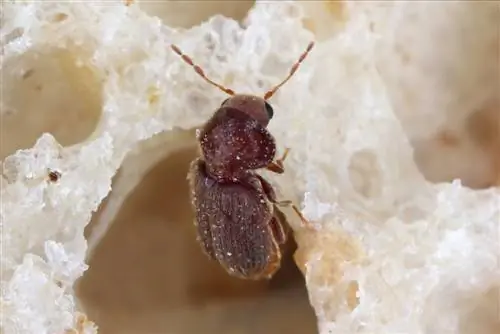
The bread beetle, as its name suggests, loves to eat bread
Flying brown beetles in the kitchen are a good reason to check all dry supplies. The reddish-brown bread beetle is a common pest of many dried foods. The brown beetle with the hard chitinous shell does not disdain newspapers, documents and books. If, using a magnifying glass, you can see longitudinal rows of dots on the elytra and light-colored hair on the head, the rodent beetle has found its way into your apartment. Adult bread beetles and voracious larvae live here:
- Supplies: in rice, in bread, in pasta, in tea or coffee, in spices, in dry food, in oatmeal, in breadcrumbs
- Place: at the window, on the windowsill, behind wooden paneling, in kitchen cupboards, between waste paper and books
You can find out how to get rid of bread beetles using simple means in the following video:

Brown fur beetle portrait
The brown fur beetle doesn't hesitate when it finds fur, wool, skins and textiles in your home. Adult, light brown, hairy beetles or the 7 to 8 mm long, bronze-brown larvae happily consume keratin-containing materials for their lives, including fallen human hair. Fur beetles in the home cannot complain about a lack of food. Typical locations are:
- In the bedroom, preferably in the wardrobe, sometimes in bed
- In the living room, often in the couch, in or on the carpet
- On the windowsill, only adult brown fur beetles
- Between cracks in parquet or laminate flooring, mostly light-shy larvae
In contrast, the common fur beetle (Attagenus pellio) is slightly larger at up to 6 mm and has a deep black, densely hairy body.
Excursus
Stink bomb in beetle shape
At first glance, the marmorated stink bug can hardly be distinguished from a beetle. Ocher-colored, marbled brown cover wings, 6 brown legs and ringed antennae characterize the appearance of the introduced Asian bug species. At a whopping 15 mm long, the insect is a giant compared to native bugs. The new citizen has been unpopular in Germany since 2010 as an invasive plant pest. If it is too cold for marbled stink bugs (Halyomorpha halys) in the fall, they will gather outside on the wall and on the windowsill to boldly migrate into the house. Anyone who defends themselves against the intruders with their hands and fly swatters will have to deal with the foul-smelling defensive weapon. Marbled stink bugs stink when crushed, which is why popular wisdom has aptly named the beasts stink bugs.
Identifying grain beetles in the house - tips on appearance and locations

The grain beetle lays its eggs in grains
Grain beetles seek proximity to all kinds of grain in order to feed on it and lay their eggs in the grains. The globally widespread stored pests can be identified by their elongated, cylindrical, brown body with a slightly flattened shape. If you take a close look at the head, you can see a proboscis as a head extension, because grain beetles belong to the weevil family. The flightless mini beetles like to stay in these places:
- Grains: wheat, rye, barley, oats, rice, corn, buckwheat
- Food: Pasta, oatmeal, muesli, dried vegetables, dry food
Closely related to the grain beetle is the red-brown, 2 to 3 mm small rice beetle (Sitophilus oryzae) with a bright, reddish spot on each wing cover as an identifying feature.
Tip
A small brown beetle on the window is usually just the tip of the iceberg. Please use the discovery as an opportunity to keep an eye out for other beetles and their tiny larvae in the apartment. Bread beetles, grain beetles and carpet beetles like to take a break from endless eating and relax on the wall.
Identifying carpet beetles - appearance and locations

Carpet beetles look like a brown ladybug
The carpet beetle is reminiscent of an Asian lady beetle in many ways. The appearance is characterized by a spherical body shape, a shiny black-brown base color and decorative markings in multi-faceted brown tones. A red elytra seam, complemented by several light transverse bands, is characteristic. What catches the eye is a pretty pronotum with bright and red spots on the sides. Carpet beetles feed on nectar and pollen. Of course, this circumstance does not give the all-clear if you find the pretty insects in the house. These are the 6 mm long, brownish, densely hairy larvae that attack carpets and textiles. These are the places you should look for the pests:
- In wardrobes
- In carpets
- In the couch
- On white-flowering houseplants, only adult carpet beetles
Target all materials that contain keratin or chitin to catch the voracious carpet beetle larvae.
Identifying a cockroach - profile of a pest
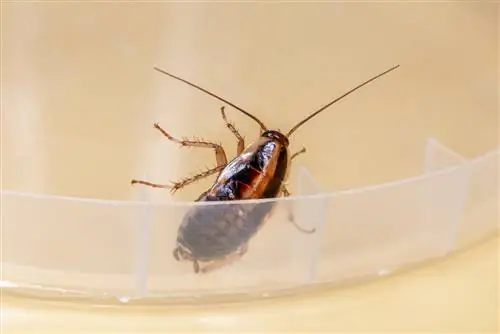
Cockroaches are larger than most brown beetles and can fly
You don't have much time to immediately distinguish a cockroach from a real beetle. The cockroach is the record holder among Germany's insects with speeds of up to 30 centimeters per second. If you catch a glimpse of the cockroach, you will see a flattened, round-oval, brown body with noticeably long antennae. An important identifying feature are two dark stripes on the neck shield. The 6 spiny legs have tiny claws that allow the beetle-like insect to move vertically on the wall. The nocturnal pest cannot fly and prefers to stay in rooms with warm, humid conditions:
- In the bathroom, often in drains and pipes
- In the basement, mostly in the laundry room
- In the kitchen, often under dishwashers and electrical appliances
- In pantries
There are only a few places in the house that are safe from cockroach infestation. The omnivores can make themselves very small in order to squeeze into cracks or hide behind the wall. Popular hiding places in the dark realm of German cockroaches are wooden floors, waste paper and the backs of cupboards or drawers.
Frequently asked questions
Which little brown bugs stink when crushed?
The marmorated stink bug (Halyomorpha halys) is called the stink bug for a reason. When crushed, the large, brown insects smell terrible. This unpleasant confrontation often occurs when stink bugs invade homes in search of winter quarters. You can avoid the stink bomb effect by putting a glass over the intruder, slipping a piece of paper under it and taking him outside.
What are those little brown bugs in the bed?
Most of the little brown beetles in the house have migrated from tropical countries. A pronounced preference for cozy, warm conditions, for example, directs the African fur beetle (Attagenus smirnovi) unerringly towards the bedroom and bed. Other cultural followers from distant countries appreciate the bed as a place to retreat or sit on the couch, such as the 2 mm small bread beetle (Stegobium paniceum) or the 3-4 mm small black-brown carpet beetle (Anthrenus scrophulariae)
Which black and brown bugs are crawling in potting soil?
The most common pests in potting soil are black-brown fungus gnats (Sciaridae) and their insatiable larvae. The slim, dark midges are 2 to 4 mm small and buzz around excitedly every time the flower pot is shaken. Adult fungus gnats only live for 5 days and do not eat solid food. It is the tiny, cream-colored larvae in the potting soil that cause significant damage to infected plants by eating roots. Matchsticks that you stick upside down in the ground and replace every 2 days have proven to be a good home remedy against the pests.
Tip
The color is an important criterion for competently identifying beetles in the house. A prime example are the 10 to 18 mm large flour beetles (Tenebrio molitor) from the black beetle family. If there are lots of small black beetles crawling in the flour, they are the dreaded carriers of parasites, such as dwarf tapeworms, and not the more harmless brown grain beetles or bread beetles.

